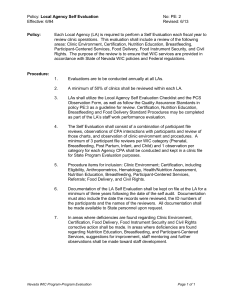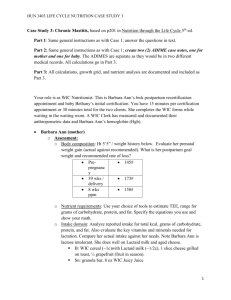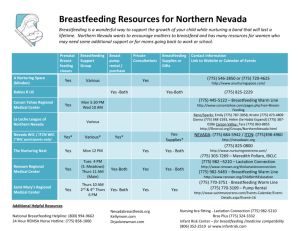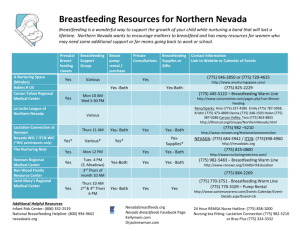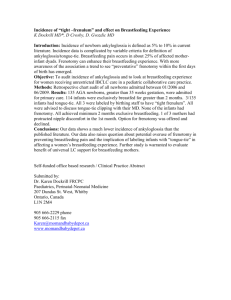1 Bilski, Amanda Bilski PH221 Assignment 1 February 18, 2015
advertisement
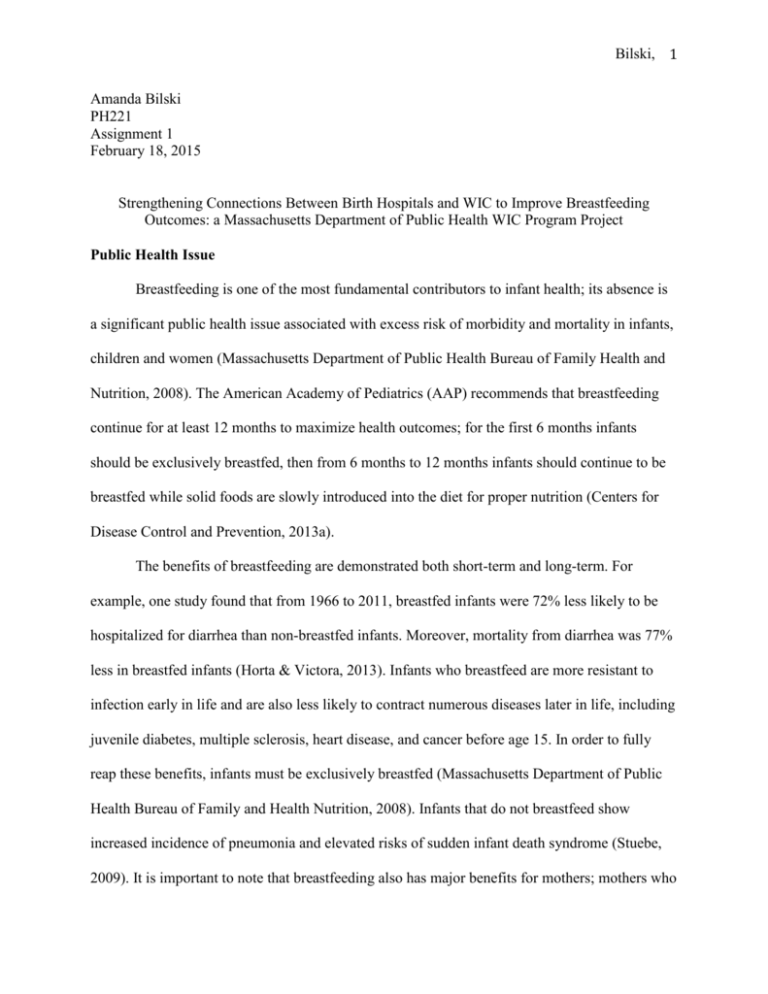
Bilski, 1 Amanda Bilski PH221 Assignment 1 February 18, 2015 Strengthening Connections Between Birth Hospitals and WIC to Improve Breastfeeding Outcomes: a Massachusetts Department of Public Health WIC Program Project Public Health Issue Breastfeeding is one of the most fundamental contributors to infant health; its absence is a significant public health issue associated with excess risk of morbidity and mortality in infants, children and women (Massachusetts Department of Public Health Bureau of Family Health and Nutrition, 2008). The American Academy of Pediatrics (AAP) recommends that breastfeeding continue for at least 12 months to maximize health outcomes; for the first 6 months infants should be exclusively breastfed, then from 6 months to 12 months infants should continue to be breastfed while solid foods are slowly introduced into the diet for proper nutrition (Centers for Disease Control and Prevention, 2013a). The benefits of breastfeeding are demonstrated both short-term and long-term. For example, one study found that from 1966 to 2011, breastfed infants were 72% less likely to be hospitalized for diarrhea than non-breastfed infants. Moreover, mortality from diarrhea was 77% less in breastfed infants (Horta & Victora, 2013). Infants who breastfeed are more resistant to infection early in life and are also less likely to contract numerous diseases later in life, including juvenile diabetes, multiple sclerosis, heart disease, and cancer before age 15. In order to fully reap these benefits, infants must be exclusively breastfed (Massachusetts Department of Public Health Bureau of Family and Health Nutrition, 2008). Infants that do not breastfeed show increased incidence of pneumonia and elevated risks of sudden infant death syndrome (Stuebe, 2009). It is important to note that breastfeeding also has major benefits for mothers; mothers who Bilski, 2 breastfeed are less likely to develop osteoporosis later in life, are more easily able to lose weight gained during pregnancy, and have a reduced risk of developing breast, uterine, and ovarian cancer (Natural Resources Defense Council, 2005). Thus, breastfeeding is a crucial modifiable risk factor for health outcomes in both mothers and infants. According to data collected by the Center for Disease Control and Prevention (CDC), 83% of all infants born in Massachusetts in 2010 were breastfed at least once. However only 20.6% of these infants were exclusively breastfeeding 6 months after birth (Centers for Disease Control and Prevention, 2013b). Furthermore, by 12 months, only 28.9% of these infants were still breastfeeding. The Commonwealth of Massachusetts must improve breastfeeding resources to increase the proportion of infants who are both exclusively and consistently breastfed until they are at least 12 months old to improve health outcomes for both infants and postpartum women. Public Health Program The Massachusetts Department of Public Health (DPH) is a governmental agency whose mission is to prevent illness, injury, and premature death, to assure access to high quality public health and health care services, and to promote wellness and health equity for all people in the Commonwealth of Massachusetts (Mass.gov, 2014a). To meet this mission, The Massachusetts DPH provides programming and services to address the needs of vulnerable populations and ensure that conditions in Massachusetts are conducive to healthy choices and lifestyles (Mass.gov, 2014a). WIC is one such federal program administered by the DPH that provides health services and programming free of charge to Massachusetts families with the ultimate goal of improving health outcomes of pregnant and breastfeeding women, new mothers, and children under the age of 5 (Mass.gov, 2014b). All WIC recipients are required to meet income Bilski, 3 guidelines, show proof of state residency and be considered a “nutritional risk” (American Pregnancy Association, 2014). WIC services include nutrition and health education, access to free healthy food, and breastfeeding support (Mass.gov, 2014c). Since one of the major goals of Massachusetts WIC is to improve nutritional status of infants, WIC encourages new mothers to exclusively breastfeed by offering educational support and providing incentives such as enhanced food packages (WIC Programs, 2014). Most recently, in 2012 the Massachusetts DPH developed the Massachusetts Baby-Friendly Collaborative, a statewide quality improvement collaborative, focused on the improvement of breastfeeding-related maternity care practices. The goal of this program is to work closely with hospitals to develop plans that will shift behaviors of new mothers towards exclusively breastfeeding unless otherwise contraindicated (Massachusetts Breastfeeding Coalition, 2014). The ultimate aim of the collaborative is to increase the number of collaborations between WIC programs and birth hospitals to improve prenatal resources and postpartum support in Massachusetts birth hospitals (Massachusetts Breastfeeding Coalition, 2014). My Applied Learning Experience is a project through the Massachusetts Baby-Friendly Collaborative titled, “Strengthening the Connections Between Birth Hospitals and WIC to Improve Breastfeeding Outcomes.” This project addresses the issues of low breastfeeding rates in Massachusetts according to AAP guidelines and the lack of breastfeeding resources available to new mothers at birth hospitals. The inputs for this project include support from the Massachusetts State Breastfeeding Coordinator at the Massachusetts DPH and from the Tufts University Institutional Review Board, access to Baby Friendly Hospital Initiative literature for review, and SurveyMonkey technology. Bilski, 4 Delivery Modes and Implementation To complete my project, I will first evaluate the extent of existing partnerships between WIC programs and birth hospitals in the United States by reviewing existing literature available online and by conducting a key informant interview with Ms. Alma Carver, a Project Manager at the National Institute for Children’s Health Quality. Once I have substantial research on the current state of WIC collaborations in the United States, I will conduct a formative evaluation of Massachusetts WIC partnerships with birth hospitals by designing a survey that will be sent to 35 WIC programs in Massachusetts and by attending biweekly Massachusetts Baby-Friendly Collaborative meetings to hear firsthand accounts of success stories and barriers to successful collaborations. Based on all of the data I collect through these activities, I will draft a set of recommendations for the 35 Massachusetts DPH WIC programs to expand and improve partnerships with Massachusetts birth hospitals. The individual WIC programs will be responsible for implementing these recommendations. Program Outputs, Outcomes, Goals, and Impacts Based on the data I collect throughout the semester through the above-mentioned activities, I will create an outline of the extent of existing partnerships between WIC programs and birth hospitals in the United States, which will identify the best practices for improved collaborations as well as barriers to success. I will also document the extent of current Massachusetts WIC partnerships with birth hospitals. These notes will ultimately be used to develop a set of recommendations for expansion of and improved partnerships with birth hospitals that I will present and distribute to Massachusetts WIC programs. These outputs will help Massachusetts WIC programs develop new partnerships with birth hospitals and strengthen existing partnerships, which will be the ultimate outcome of my project. The short-term impact Bilski, 5 of this project will be an increase in prenatal resources and postpartum support available to prenatal mothers. Long-term this project will increase the rate of women in Massachusetts who breastfeed their children according to AAP guidelines and therefore will improve health outcomes for both infants and postpartum women in Massachusetts. Success of Program This program has the potential to improve breastfeeding rates in Massachusetts by facilitating strengthened relationships between WIC programs and birth hospitals. With WIC as partner organizations, birth hospitals will have increased resources to provide prenatal and postpartum mothers, which will increase education about the importance of breastfeeding, what to expect, and techniques to improve likelihood of successful breastfeeding. Strengths and Weaknesses The concept of this project is very clear and has the potential to significantly improve relationships between WIC programs and birth hospitals. This is a strength because it is easy to explain the aims of this project to WIC breastfeeding coordinators and other key informants who are providing feedback, allowing for data collection to be a relatively seamless process. The biggest weakness in this project is the methodology of data collection. The survey is mostly quantitative with a few opportunities for participants to provide comments. While these comments will be helpful, each WIC breastfeeding coordinator has vastly different experiences because they work in different regions with different hospitals and birth facilities, so in some instances it may be difficult to code and categorize these responses. Another limitation is that relationships are affected by personal traits, which cannot be controlled in this situation. Additionally, once the WIC program directors receive my recommendations, there is currently no infrastructure in place to enforce their implementation. Bilski, 6 Logic Model Bilski, 7 References American Pregnancy Association (2014). WIC. Retrieved from http://americanpregnancy.org/planning/wic/ Centers for Disease Control and Prevention (2013a). Breastfeeding Frequently Asked Questions. Retrieved from http://www.cdc.gov/breastfeeding/faq/ Centers for Disease Control and Prevention (2013b). Breastfeeding Report Card. Retrieved from http://www.cdc.gov/breastfeeding/pdf/2013breastfeedingreportcard.pdf Horta B.L. & Victora C.G. (2013) Short-term effects of breastfeeding: A systematic review on the benefits of breastfeeding on diarrhoea and pneumonia mortality. World Health Organization. Retrieved from: http://www.who.int/maternal_child_adolescent/documents/breastfeeding_short_term_effe cts/en/ Mass.gov (2014a). Welcome from Commissioner Cheryl Bartlett. The Official Website of the Executive Office of Health and Human Services (EOHHS). Retrieved from http://www.mass.gov/eohhs/gov/departments/dph/welcomewel2.html Mass.gov (2014b). What does WIC offer? The Official Website of the Executive Office of Health and Human Services (EOHHS). Retrieved from http://www.mass.gov/eohhs/consumer/basic-needs/food/wic/participants/what-does-wicoffer.html Mass.gov (2014c). Women, Infants and Children (WIC) Nutrition Program. The Official Website of the Executive Office of Health and Human Services (EOHHS). Retrieved from http://www.mass.gov/eohhs/consumer/basic-needs/food/wic/ Massachusetts Breastfeeding Coalition (2014). Massachusetts baby-friendly collaborative. Retrieved from http://massbreastfeeding.org/providers/collaborative/ Massachusetts Department of Public Health Bureau of Family Health and Nutrition (2008). Guidelines for Breastfeeding Initiation and Support. Retrieved from http://www.mass.gov/eohhs/docs/dph/com-health/nutrition/breastfeeding-guidelines.pdf Natural Resources Defense Council (2005). Benefits of Breastfeeding. Retrieved from http://www.nrdc.org/breastmilk/benefits.asp Stuebe, A (2009). The risks of not breastfeeding for mothers and infants. Reviews in Obstetrics & Gynecology 2(4): 222-231. WIC Programs (2014). Massachusetts WIC further benefits. Retrieved from http://www.wicprograms.org/state/massachusetts
